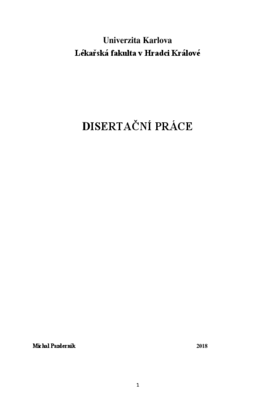Klinické projevy infekční endokarditidy v závislosti na infekčním agens
Clinical Manifestations of Infective Endocarditis Depending on Infectious Agent
dizertační práce (OBHÁJENO)

Zobrazit/
Trvalý odkaz
http://hdl.handle.net/20.500.11956/99878Identifikátory
SIS: 160304
Kolekce
- Kvalifikační práce [1195]
Autor
Vedoucí práce
Oponent práce
Táborský, Miloš
Vítovec, Jiří
Fakulta / součást
Lékařská fakulta v Hradci Králové
Obor
-
Katedra / ústav / klinika
Katedra interních oborů
Datum obhajoby
25. 6. 2018
Nakladatel
Univerzita Karlova, Lékařská fakulta v Hradci KrálovéJazyk
Čeština
Známka
Prospěl
Úvod: I přes neustálé pokroky v konzervativní i chirurgické terapii infekční endokarditidy (IE) bývá tento syndrom doprovázen značnými komplikacemi a zůstává život ohrožující infekcí. Dle statistik Světové zdravotnické organizace má Česká republika celosvětově jednu z nejvyšších mortalit spojenou s tímto onemocněním. Cíle a metodika: Byla provedena studie místních případů IE ve dvou vedoucích zdravotnických centrech České republiky. Hlavním cílem byla analýza charakteristických rysů tohoto onemocnění a současně snaha o určení prediktorů, které jsou spojeny s rozvojem akutních komplikací a horším přežíváním pacientů s IE. Výsledky: Infekce aortální chlopenní náhrady byla významným prediktorem paravalvulárního šíření infekce (OR 6,706). Infekce Staphylococcus aureus (OR 8,459) a kouření (OR 8,403) byly spojeny s častějším rozvojem septického šoku (OR 8,403). Nejrizikovější stran možné embolizace byla vegetace ≥13 mm na mitrální chlopni (OR 3,59) a IE způsobená Staphylococcus aureus (OR 3,24). Velikost vegetace nebyla spojena pouze s rizikem samotné embolizace, ale i s lokálním destruktivním působením ve formě vzniku nového prolapsu/perforace chlopně (OR 1,055). Důležitost kardiochirurgické (KCH) operace ve spojitosti s přežíváním pacientů byla prokázána ve všech segmentech naší práce - nemocniční úmrtnosti,...
Introduction: Despite more recent advances in both medical and surgical therapies, the syndrome of infective endocarditis (IE) continues to be characterized by serious complications, and remains a life-threatening infection. According to data from the World Health Organization, the Czech Republic has one of the highest mortality rates due to this disease worldwide. Aims and methods: A study of local IE cases was conducted in two leading Cardiac centres in the Czech Republic. The main objective was to analyse the features of this disease and, at the same time, to identify predictors that are associated with the development of acute complications and worse survival of patients with IE. Results: Infection of the aortic prosthesis was a significant predictor of paravalvular spread of infection (OR 6.706). Infection caused by Staphylococcus aureus (OR 8.459) and smoking (OR 8.403) were associated with a more frequent development of septic shock (OR 8.403). The most potent risk factors of possible embolization were mitral valve vegetation ≥ 13 mm (OR 3.59) and IE caused by Staphylococcus aureus (OR 3.24). The size of the vegetation was not only associated with the risk of embolization itself but also with a local destructive effect in the form of a new prolapse/perforation of the valve (OR 1.055). The importance...
